Takamine guitars are well known in the acoustic world for their legendary guitars. Founded in central Japan and taking its name from Mount Takamine in the vicinity, the brand always had an impressive classical guitar line: from its affordable G Series for the value and budget-conscious crowd to the high-end Hirade Series named after its master luthier Mass Hirade.
Each of the Series has its electric classical models – sometimes with a cutaway design and sometimes not – which are highly regarded for their overall quality and performance.
Table of Contents
Takamine G Series classical guitars for beginners
Fondly known as the ‘Tak’ by its fans, the G Series is Takamine’s value line of guitars. These guitars are a great way to get into guitar. The popular models in this line are the GC1-NAT (for ‘natural’ or not electric, so pure classical style guitar), GC3-NAT and GC5-NAT.
Each of these models has its cutaway electric variants if the beginner so chooses and are named with a ‘CE’ added (presumably for ‘cutaway electric’) to the variant names: GC1CE, GC3CE and GC5CE.
GC1-NAT for the novice
The GC1-NAT is an attractive classical acoustic guitar aimed at beginning players. It performs well above its price tag for a balanced sound. It features a dovetail neck joint, an inlaid mosaic rosette, synthetic bone nut and bridge saddle, laurel head cap, chrome tuners with white pearl buttons and an elegant gloss finish.
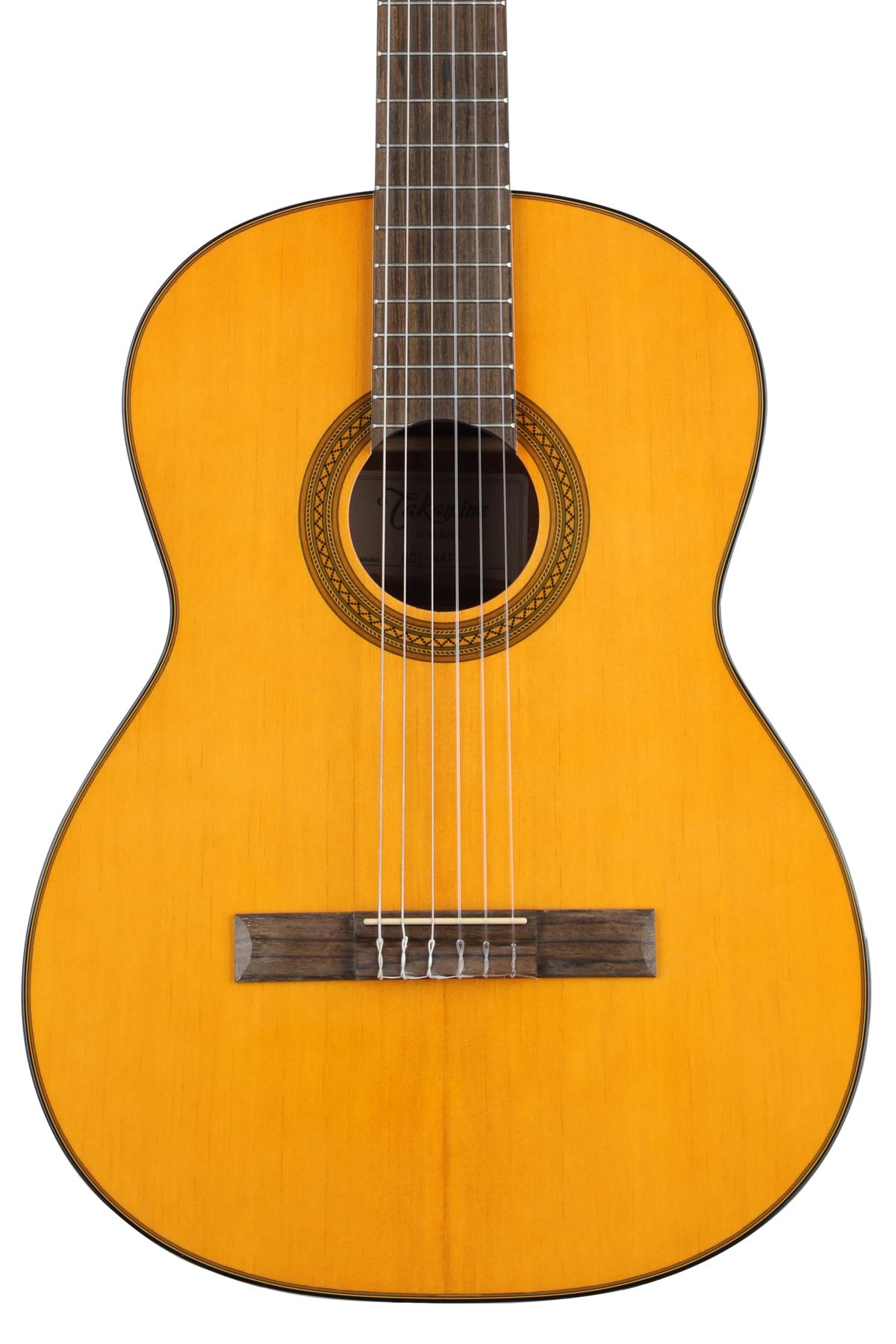
The GC1 features a fan-braced spruce top with mahogany back and sides. It is known for its full-bodied tone. Many users consider it as an ideal first classical guitar.
The GC1-NAT is a replacement for the earlier, now discontinued G124. It comes with its entry-level features for beginners and weekend strummers: ply spruce top, mahogany back and sides, mahogany neck, rosewood fingerboard and an adjustable truss rod. It uses a similar headstock and slim neck design as the pro Takamine guitars.
It is a full-size classical guitar with a 51mm nut width and 650 mm scale length (distance between the saddle and nut).
| Takamine GC1-NAT | |
| Finish: | Gloss |
| Top Wood: | Spruce |
| Back & Sides Wood: | Mahogany |
| Body Bracing: | Classical Fan |
| Neck Wood: | Mahogany |
| Fingerboard Material: | Laurel |
| Number of Frets: | 19 |
| Scale Length: | 650 mm (25.6”) |
| Tuning Machines: | Chrome Classical with White Pearl Buttons |
| Bridge Material: | Laurel with Compensated Saddle |
| Nut/Saddle Material: | Synthetic Bone |
| Nut Width: | 2″ |
| Strings: | D’Addario EXP45 Normal Tension |
| Price link: | Check the price of GC1-NAT at Sweetwater |
GC3-NAT: A step up from the basic
The GC3-NAT is the step up from the GC1, the key improvement being the addition of a solid spruce top. It is a great classical guitar that features solid-top construction and a beautiful gloss finish with the full, rich sound of a Takamine classical guitar.
Check the price of Takamine GC3-NAT at Amazon.
Perfect for an advanced beginner who knows their way on the fretboard, the GC3 is a great all-round classical guitar. It features a fan-braced solid spruce top with mahogany back and sides for a resonant sound. The comfortable mahogany neck and laurel fingerboard provide great feel and playability.
Other features include a dovetail neck joint, synthetic bone nut and bridge saddle, laurel head cap, chrome tuners with white pearl buttons and a gloss finish.
The GC3-NAT was introduced in 2014 as a replacement for the popular, now discontinued G124S. Its tone is more refined than a total beginner’s guitar for demanding beginners and weekend strummers. It uses a similar headstock and slim neck design as pro Takamine guitars.
It is a full-size classical guitar with a 51mm nut and 650 mm scale length (distance between the saddle and nut).
GC5-NAT for the advanced beginner
This is a good classical guitar worthy of attention from a serious beginner or an early intermediate student of the instrument. It features solid-top construction with cosmetics and a warm, resonant sound that Taks are known for. By far the biggest step-up in sound quality comes when you move from a ply soundboard to solid spruce or cedar. Because a solid wood soundboard like spruce is more responsive than plywood and improves with regular use.
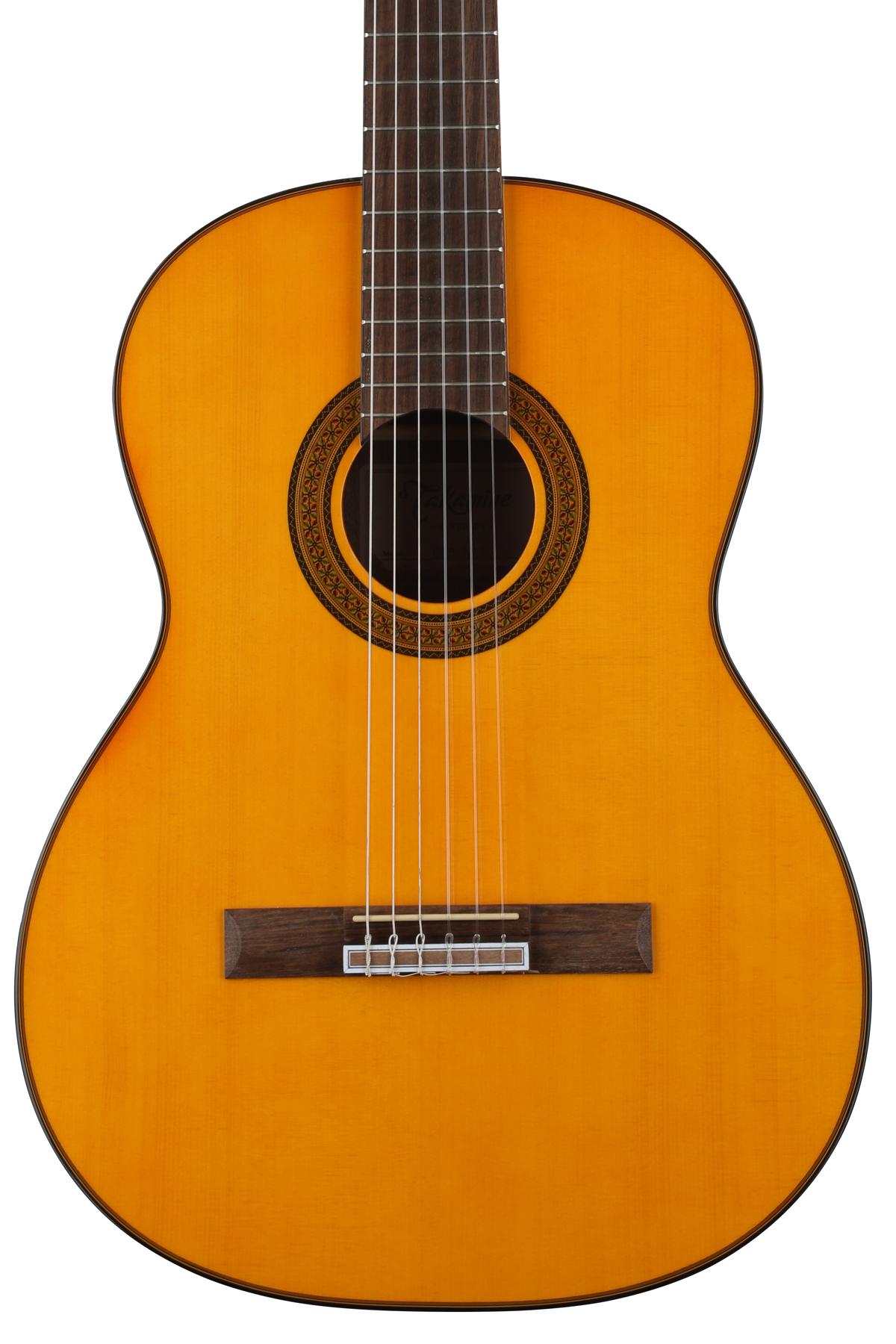
The GC5 also features a beautiful inlaid mosaic rosette, synthetic bone nut and bridge saddle, laurel head cap, gold tuners with white pearl buttons and a luxurious gloss finish.
An ideal choice for players looking for a refined and well-balanced classical guitar, the GC5 combines a fan-braced solid spruce top with black walnut back and sides to produce the rich, nylon-string Takamine tone. The comfortable mahogany neck and laurel fingerboard provide a great feel and playability, while the dovetail neck joint provides superior wood-to-wood contact for better resonance and excellent structural stability.
The GC5-NAT too was introduced in 2014 as the replacement for the popular G128S. It’s essentially the same as the G128S with the addition of a ’T’ on the headstock. It is a full-size classical guitar with a 51mm nut and 650 mm scale length (distance between the saddle and nut).
Overall, the GC5 is a very good step-up classical guitar that is quite affordable while giving the player a discernible jump in quality.
| Takamine GC5-NAT | |
| Color: | Natural |
| Finish: | Gloss |
| Top Wood: | Solid Spruce |
| Back & Sides Wood: | Black Walnut |
| Body Bracing: | Classical Fan |
| Neck Wood: | Mahogany |
| Fingerboard Material: | Laurel |
| Number of Frets: | 19 |
| Scale Length: | 650 mm (25.6”) |
| Tuning Machines: | Gold die-cast tuners with pearl buttons |
| Bridge Material: | Laurel with Compensated Saddle |
| Nut/Saddle Material: | Synthetic Bone |
| Nut Width: | 2″ |
| Strings: | D’Addario EXP45 Normal Tension |
| Price link: | Check the price of GC5-NAT at Sweetwater |
GC5CE-NAT: Electric cutaway classical
For beginners interested in playing pop/rock/jazz on nylon strings, the GC5CE-NAT is basically the popular GC5 with electronics and cutaway design added. This is a serious model to consider even for acoustic players crossing over to check out a good nylon-string guitar.
The GC5CE features a solid-top construction and a Venetian-style cutaway with the added Takamine electronics section. It is an acoustic-electric classical guitar ready to take on your gigs.
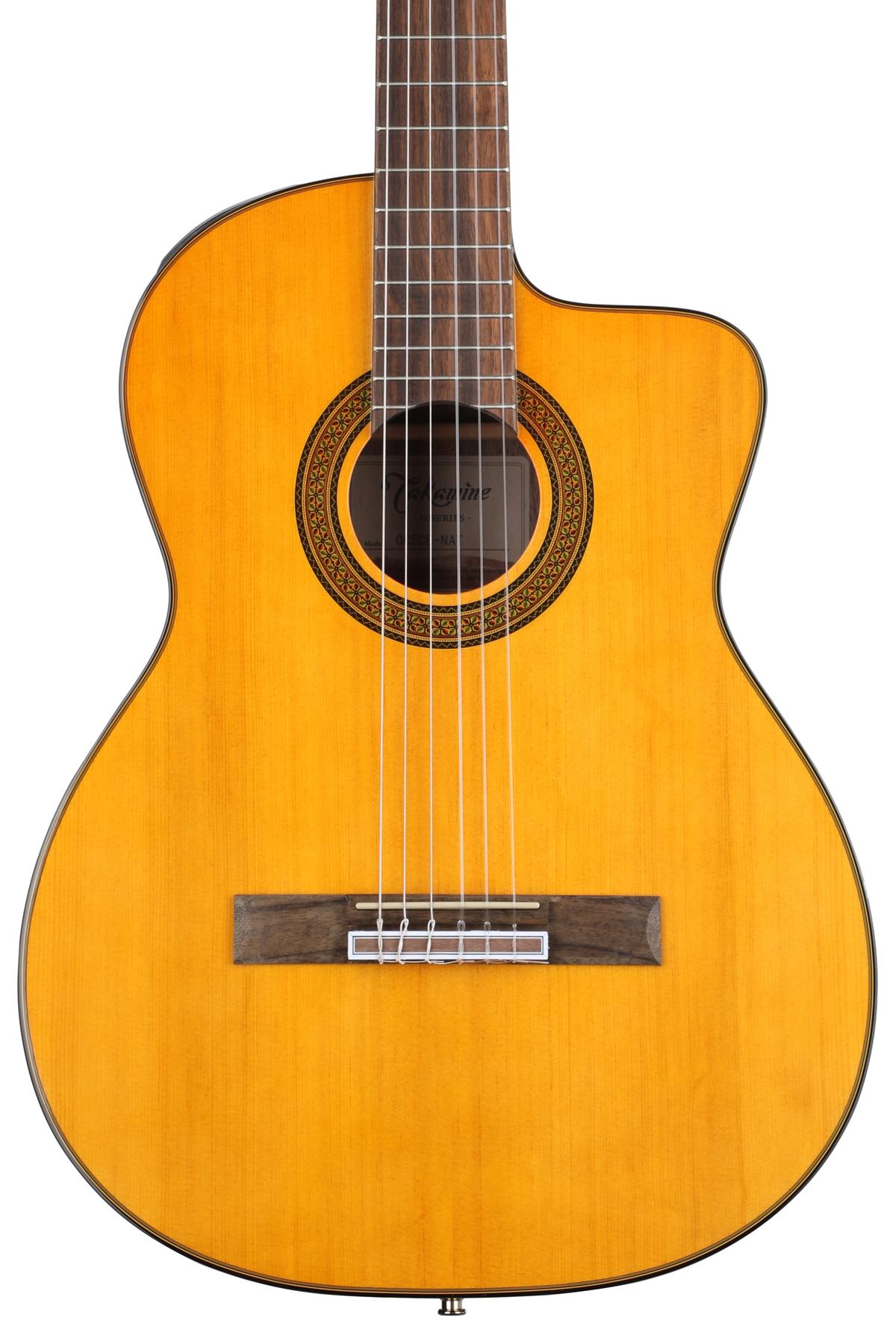
It comes with its traditional classical guitar build for the most part: a fan-braced solid spruce top and black walnut back and sides that produce a warm, rich nylon-string sound. The slim mahogany neck and laurel fingerboard provide a great feel and playability. Other features include a dovetail neck joint, beautiful inlaid mosaic rosette, synthetic bone nut and bridge saddle, and gold tuners with white pearl buttons.
The cutaway design provides easy access to higher frets. The onboard Takamine TP-4T preamp system gives you a built-in tuner with three-band EQ and gain controls for amplified performance and versatility.
The GC5CE-NAT is the replacement for the earlier and popular EG128SC. It is an acoustic-electric package for the classical guitarist needing a pickup system for coffee house gigs and restaurants.
If you wish to enter the world of acoustic-electric classical guitars, the GC5CE is a great and tried-and-trusted guitar to undertake that journey. The feel is comfortably classical (within reason) and the playability is very comfortably acoustic/electric with the cutaway and amplification. It is quite an affordable option too for the quality it delivers.
| Takamine GC5CE | |
| Body Style: | Single Cutaway |
| Left-/Right-handed: | Right-handed |
| Finish: | Gloss |
| Top Wood: | Solid Spruce |
| Back & Sides Wood: | Black Walnut |
| Body Bracing: | Classical Fan |
| Neck Wood: | Mahogany |
| Fingerboard Material: | Laurel |
| Number of Frets: | 19 |
| Scale Length: | 650 mm (25.6”) |
| Tuning Machines: | Gold die-cast tuners with pearl buttons |
| Bridge Material: | Laurel with Compensated Saddle |
| Nut/Saddle Material: | Synthetic Bone |
| Nut Width: | 2″ |
| Electronics: | Takamine TP-4T preamp with 3-band EQ and built-in tuner |
| Strings: | D’Addario EXP45 Normal Tension |
| Price link: | Check the price of GC5CE at Sweetwater |
Takamine classical guitars for intermediate players
There is quite a range of classical guitars from Takamine for both the early intermediate to advanced intermediate guitarists who perform gigs. Again, there is the choice of what may be called pure classical guitars as well as electric crossovers with or without the cutaway design. Here’s a listing of the more popular choices.
C132S ‘pure’ classical guitar
The C132S is Takamine’s midrange classical guitar and great value for money. It is a handmade guitar from Sakashita, Japan. This instrument is designed for discriminating classical guitar students and is one of the best-selling classical guitars in the USA. It is in the same league as the other popular guitar in this segment, the Cordoba C10. Check the price of the Takamine C132S at Amazon.
This nylon string classical guitar is built to traditional classical guitar construction. It is said to follow closely to the original drawings of Antonio Torres, the inventor of the modern classical guitar. The solid cedar top is supported by a traditional ladder bracing. The rosewood back and sides aid in projection. The mahogany neck features a dual-action truss rod, which allows for adjustment for the neck angle as the player desires. In practice, this hardly needs to be fiddled with at all.
The slender neck and low profile frets make for easy playability for a guitar in this class. Plus, it has all the expected features like a solid cedar top, solid rosewood back, rosewood fingerboard, solid mahogany neck, bone nut and bone saddle as well as gold plated tuning heads.
It is a full size, full-featured classical guitar with a 51mm nut width and 650 mm scale length.
TC132SC: Related electric cutaway classical
Take the above-mentioned Takemine C132S and add some electronics to it along with a cutaway design. What you get is the TC132SC, a handcrafted classical guitar from Takamine’s pro series facility.
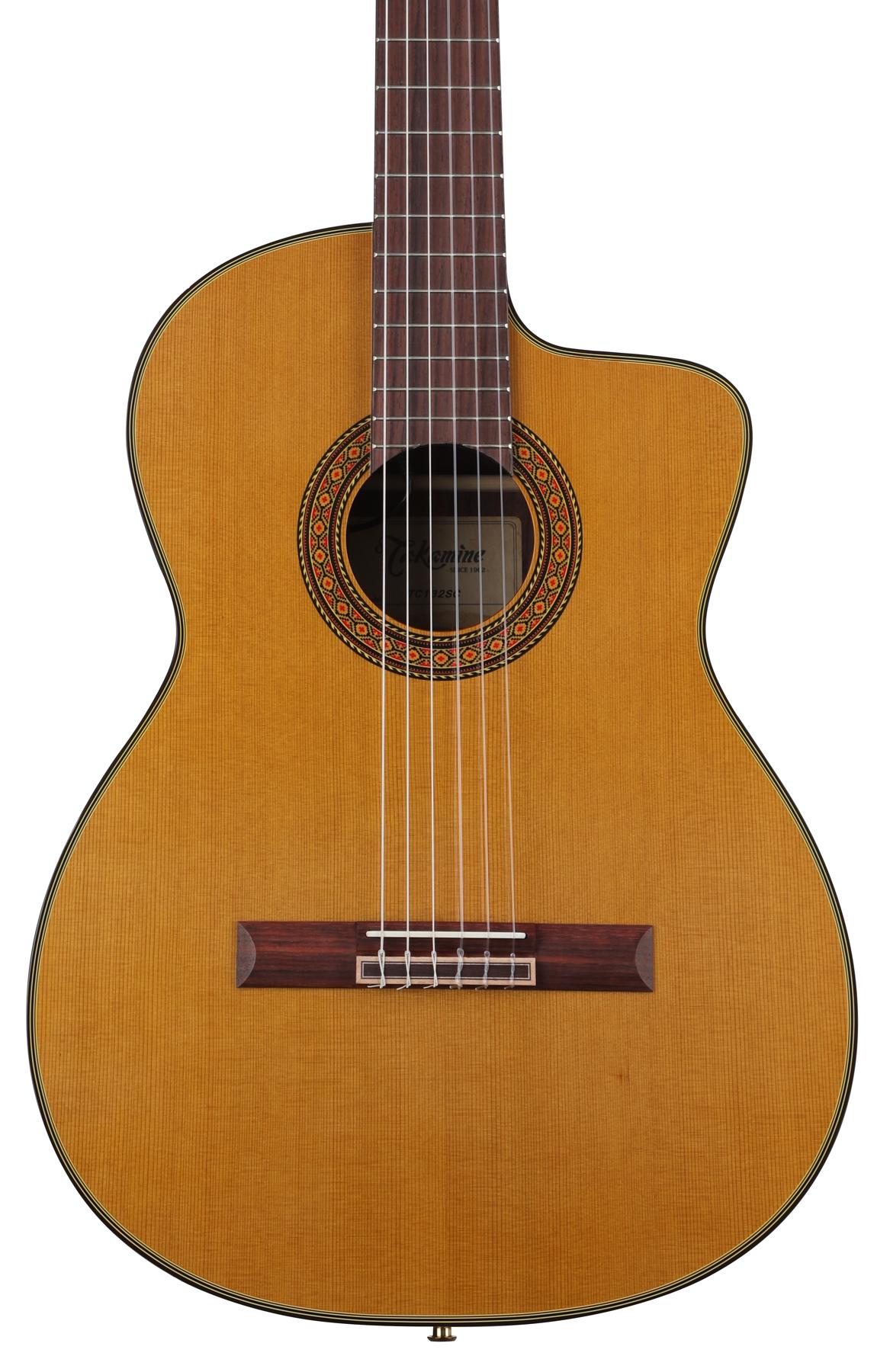
This is the very guitar that the Eagles used in their acoustic version of Hotel California.
This nylon string classical guitar includes Takamine’s proprietary CTP-3 Cool Tube preamp system. The CTP-3 provides a low-voltage tube tone, from brilliant to warm. It has a 3-band EQ and an onboard chromatic tuner.
This model is perfect for classical guitarists bound for wedding, party and restaurant venues. You are likely to meet jazz guitarists with a pure nylon string tone with the TC132SC in hand.
As a traditional classical instrument, the TC132SC follows closely to the original drawings of Antonio Torres. The solid cedar top produces a warm full tone with plenty of dynamic range. The solid rosewood back aids in the projection and enhances the sonic brilliance of the instruments. The mahogany neck features a dual-action truss rod. And the finish is gloss.
The 132 Series guitars from Takamine have a lot of nostalgia attached to them. They are classics.
| Takamine TC132SC | |
| Body Style: | Single Cutaway |
| Finish: | Gloss Natural |
| Top Wood: | Solid Cedar |
| Back & Sides Wood: | Solid Rosewood (back), Laminate Rosewood (sides) |
| Body Bracing: | Traditional Fan |
| Neck Wood: | Mahogany |
| Fingerboard Material: | Rosewood |
| Number of Frets: | 18 |
| Scale Length: | 25.59″ |
| Tuning Machines: | Gold Classical |
| Bridge Material: | Rosewood |
| Nut/Saddle Material: | Bone |
| Nut Width: | 2.008″ |
| Electronics: | CTP-3 Cool Tube 12AU7 preamp system with 3-band EQ |
| Strings: | D’Addario EXP45 Normal Tension |
| Price link: | Check the price of TC132SC at Sweetwater |
TH5C acoustic-electric classical from the Hirade Series
Hirade is Takamine’s premium line of classical guitars, originally designed by master luthier Mass Hirade. These guitars are constructed of fine tonewoods and handmade in Sakashita, Japan. Check the price of Takamine TH5C at Amazon.
The TH5C Hirade concert classic is a handcrafted model in Takamine’s pro series. It is “designed and built to stand beside the finest classical guitars made today.”
The TH5C is an acoustic-electric cutaway version of the original acoustic, high-end H5. The H5 sound is amped with the Cool Tubes II preamp (CTP-2). It includes a chromatic tuner, 3-band EQ and is fed by the Palathetic under-saddle pickup. This guitar goes from teaching aid to gig monster pretty much on demand.
It is a full-size classical guitar (with electronics) with a standard 51 mm nut width and 650 mm scale length.
Many users (including Joshua Rogers in the video below) are surprised at how heavy the TH5C is compared to a regular classical guitar. The Cool Tubes pickup hardware probably has a lot to do with the weight gain. But the pickup sounds great. Sustain increases when compared to acoustic playing so you need to be careful about stopping bass notes from ringing.
Most classical guitarists buy this guitar for amping up on gigs with the great pickup. However, the straight acoustic tone is warm and sweet, responding well to vibrato. It is a good guitar to make recordings. Notes are consistent in tone and volume as you move between positions and registers. Watch guitarist and teacher from New Zealand Joshua Rogers have his say on the TH5C. And you’ll understand why this is a popular choice among those who perform.
Joshua Rogers review of Takamine TH5C
TH8SS acoustic-electric classical from the Hirade Series
This is a stunning classical guitar from Takamine based on the purely acoustic H8SS. Both the H8SS and TH8SS are traditional in design and appearance, owing much to Mass Hirade’s emulation of the Jose Ramirez design. (The SS stands for Solid Solid to distinguish the basic model from the earlier H8 model with its laminated back and sides.)
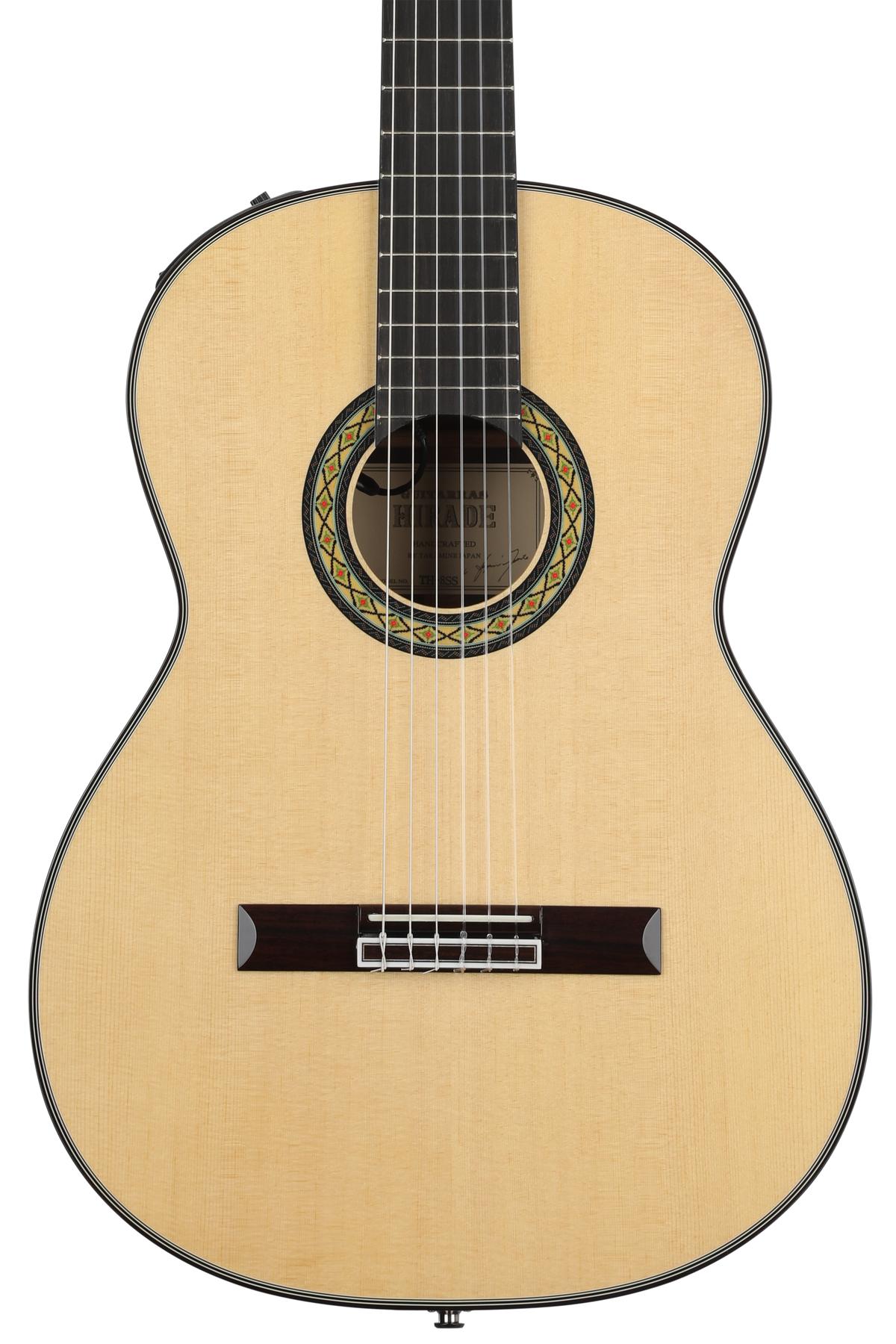
What sets them apart from typical Spanish classical guitars is a more slender neck than average, a polyester finish and, in the case of the TH-8SS, the pickup system, of course
A classic pairing of spruce and rosewood gives this guitar its voice. And since it’s made with all-solid tonewoods, the H8SS provides a range of tones that players of all styles can appreciate. For plugged-in performances, you can rely on the onboard CTP-3 Cool Tube preamp to deliver an impressive tone. It also has a built-in chromatic tuner and 3-band EQ for extra versatility.
The TH8SS is a well-crafted guitar. With great playability and tone. A solid spruce top is a favorite of luthiers for centuries, for its powerful projection and brilliant tone. The top is matched to an all-solid rosewood body. Rosewood is one of the most highly sought-after tonewoods due to its deep tone and textured midrange. Next, the body is joined to a mahogany neck topped with an ebony fingerboard. Together, these solid tonewoods produce a tone that is nuanced yet simultaneously punchy.
For all its onboard electronics and wizardry, the TH8SS is NOT a cutaway guitar. It gives you the option to go electric on a standard classical style body and design.
The well-liked Takamine’s Cooltube CTP-3 preamp system runs a tube at low voltage to prevent it from heating up and affecting your guitar. The sound is natural and rich, with exceptional dynamics. It also houses a built-in chromatic tuner, a Notch control, and a sweepable Mid-Frequency control to really dial in your perfect tone.
An Aux jack allows you to install an additional pickup source to be blended with Takemine’s under-saddle pickup for adding more detail and warmth to your live acoustic sound.
| Takamine TH8SS | |
| Color: | Natural |
| Finish: | Gloss |
| Top Wood: | Solid Spruce |
| Back & Sides Wood: | Solid Rosewood |
| Neck Wood: | Mahogany |
| Fingerboard Material: | Ebony |
| Number of Frets: | 19 |
| Scale Length: | 25.5″ |
| Tuning Machines: | Open Gear |
| Bridge Material: | Ebony |
| Nut Width: | 2.0″ |
| Electronics: | CTP-3 preamp with tuner |
| Strings: | D’Addario Pro Arte |
| Case Included: | Hardshell Case |
| Price link: | Check the price of TH8SS at Sweetwater |
Anton Losy’s Allemande performed on the TH8SS
______________
If you are considering electric cutaway classical guitars, I will recommend my article on 6 Options of Cutaway Classical Guitars. It will introduce you to the main options out there and their key features. You can weigh those against what the Takamine options here give you.
Happy choosing!





Thanks for the details! I own both the C132 and the H8SS. Very good guitars. How do you think that they compare to Alhambra 7/8/9P?
Those are two fine specimens, aren’t they? I’ve played the C132 and also own a 7P. These two are very comparable in my view and roughly in the same ball park, feature-wise and in terms of overall construction, playability and price. The 7P has a darker, ‘Spanish’ traditional sound to it and the 132 has a more modern ring to it. The H8SS is a great sounding guitar that I’ve listened to, although not played. Thanks for dropping by!